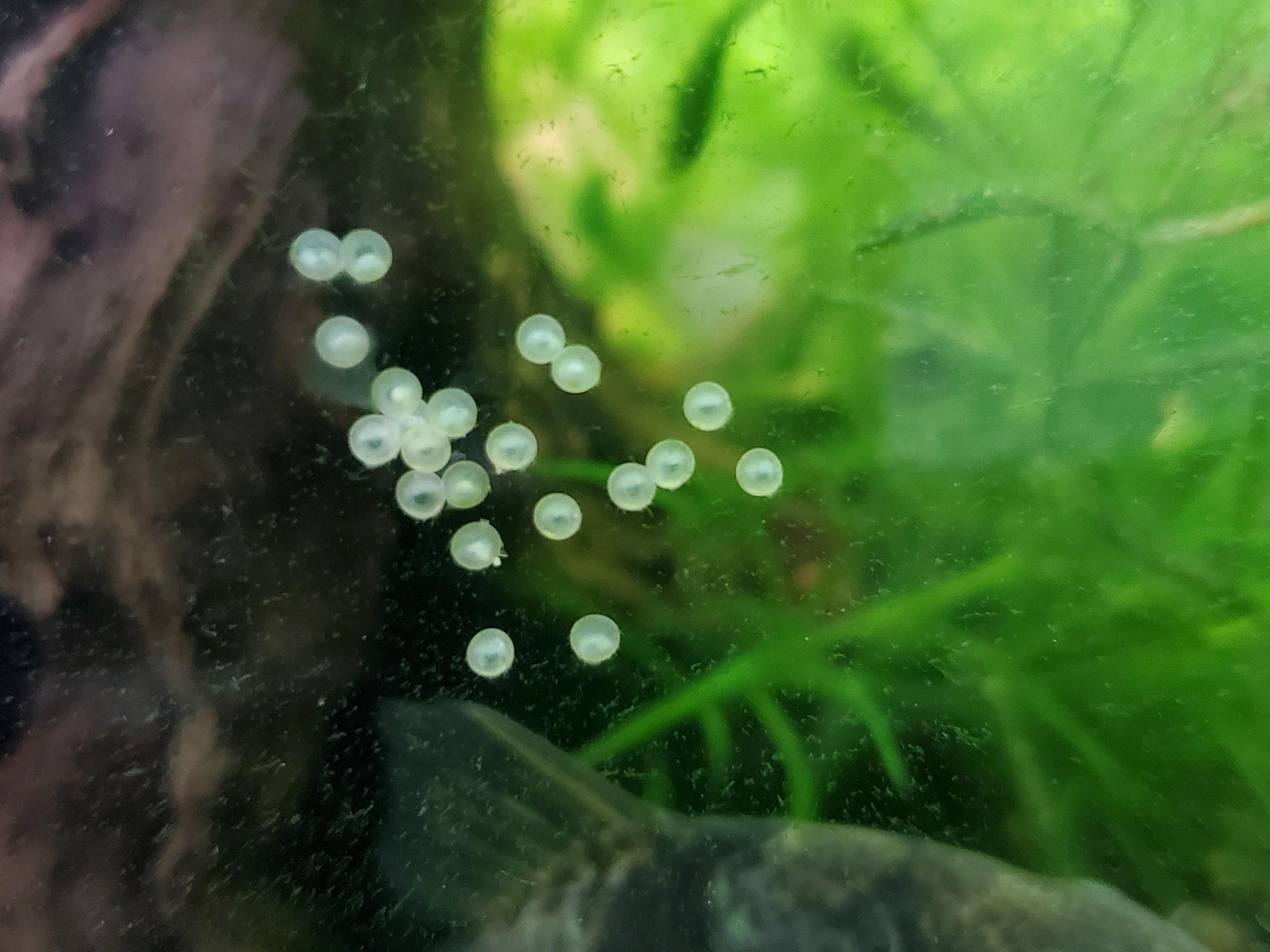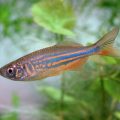Corydoras, also known as Cory Catfish, are popular freshwater aquarium fish that are loved for their peaceful nature and unique appearance. These small catfish are native to South America and can be found in various rivers and streams in the region.
One of the common concerns among aquarium enthusiasts is whether Corydoras eat snail eggs. Snails are known to reproduce rapidly and can become a nuisance in some aquariums, so finding a natural predator to control their population is desirable. Fortunately, Corydoras are known to have a healthy appetite for snail eggs and can help keep their numbers in check.
Corydoras are omnivorous fish, meaning they have a varied diet that includes both plant matter and small invertebrates. While they primarily feed on algae, detritus, and small crustaceans, they will also consume snail eggs if given the opportunity. Snail eggs are usually laid on hard surfaces, such as rocks or decorations in the aquarium, and can be easily spotted by the keen-eyed Corydoras.
The feeding behavior of Corydoras is quite fascinating to observe. They have specialized mouthparts that allow them to sift through substrate and search for food. They use their barbels, which are whisker-like projections around their mouth, to locate and taste their prey. Once they find snail eggs, they will eagerly consume them, helping to control the snail population in the aquarium.
It’s important to note that while Corydoras do eat snail eggs, they may not eliminate the problem entirely. Snails are prolific breeders and can lay hundreds of eggs at a time. Therefore, it’s recommended to combine Corydoras with other snail control methods, such as manual removal or introducing snail-eating fish like Assassin Snails or Pea Puffers.
In addition to their appetite for snail eggs, Corydoras are also beneficial tank mates for other reasons. They are peaceful and get along well with a wide range of fish species. They are also known to be excellent cleaners, as they will graze on uneaten food and help keep the aquarium clean. However, it’s important to provide them with a suitable environment that includes plenty of hiding spots and soft substrate to mimic their natural habitat.
Corydoras are indeed known to eat snail eggs and can be a valuable addition to an aquarium struggling with a snail population. Their natural feeding behavior and specialized mouthparts make them efficient snail egg hunters. However, it’s important to remember that they may not completely eradicate the snail problem on their own, and combining them with other snail control methods is recommended for optimal results.
What Fish Will Eat Snail Eggs?
Here is a detailed list of fish that are known to eat snail eggs:
– YoYo Loach (Scientific name: Botia almorhae / B. rostrata): This fish is highly effective in controlling snail populations as it actively seeks out and consumes both snails and their eggs.
– Pea Puffer (Freshwater Pea Puffers): These small fish have a voracious appetite for snails and their eggs. They are known to be skilled snail hunters and can significantly reduce snail populations in an aquarium.
– Dwarf Chain Loach (Scientific name: Ambastaia sidthimunki): These loaches are known to feed on snails and their eggs. They are small in size but can be quite effective in controlling snail populations.
– Gouramis: Some species of gouramis, such as the Three Spot Gourami (Trichopodus trichopterus), have been observed to eat snail eggs. However, their effectiveness may vary depending on individual behavior and tank conditions.
– Bala Shark (Balantiocheilus melanopterus): While primarily known for their peaceful nature and impressive size, Bala Sharks have also been observed to eat snail eggs, making them potential snail control options.
– Assassin Snail (Clea helena): Although not a fish, assassin snails are highly effective in controlling snail populations. They specifically target and consume snails, including their eggs.
– African Cichlids: Some species of African Cichlids, such as the Mbuna Cichlids, have been known to eat snail eggs. However, it is important to note that African Cichlids require specific tank conditions and should be chosen carefully to ensure compatibility with other fish.
– Goldfish: Goldfish are opportunistic eaters and may consume snail eggs if given the chance. However, their effectiveness in controlling snail populations may vary, and they require appropriate tank size and water conditions.
It is important to note that while these fish may eat snail eggs, they might not completely eradicate snail populations. The effectiveness of snail control can depend on various factors such as tank size, water parameters, and the number of snails present.

Will Corys Eat Fish Eggs?
Corydoras (commonly known as corys) are known to eat fish eggs. These small catfish species do not exhibit any post-spawning care for their eggs, unlike some other fish species. Therefore, leaving the eggs in the same aquarium as the corys can result in the eggs being consumed by the adult fish.
Here are a few key points:
– Corydoras are not attentive parents and do not provide any form of care for their eggs or fry (young fish).
– The absence of post-spawning care means that the corys are not inclined to protect or nurture their eggs.
– In fact, corydoras are opportunistic feeders and will consume any available food source, including fish eggs.
– It is important to note that corys are omnivorous and their diet can consist of various types of food, including small invertebrates, algae, and organic detritus.
– Due to their natural feeding behavior, corydoras may see fish eggs as a potential food source and consume them if given the opportunity.
– To prevent the loss of fish eggs, it is advisable to remove the eggs from the aquarium housing the corydoras and place them in a separate tank or breeding box where they can be protected until they hatch.
Corydoras are known to eat fish eggs due to their opportunistic feeding behavior and lack of parental care. To ensure the survival of fish eggs, it is recommended to remove them from the aquarium housing corys and provide a separate environment for their protection.
Will Cory Cats Eat Snail Poop?
Corydoras, commonly known as cory cats, are a type of catfish that are often included in aquariums as part of a “clean up crew.” They are known for their scavenging behavior, which involves eating leftover food and other organic matter in the tank. While they may consume some small particles of snail poop as they forage for food, it is not their primary source of nutrition.
Cory cats have a preference for live or frozen foods such as bloodworms, brine shrimp, and daphnia. They also consume sinking pellets or flakes specifically designed for bottom-dwelling fish. These foods provide them with the necessary nutrients to thrive.
It is worth noting that snails themselves are also considered part of the “clean up crew” in some aquariums. They help to control algae growth and consume decaying plant matter and detritus. However, snail poop is generally not a significant concern as it tends to break down and decompose naturally in the tank.
While corydoras may consume small particles of snail poop as they scavenge for food, it is not their primary source of nutrition, and they are not specifically adapted to eat snail poop.
What Snails Can Live With Cory Catfish?
When it comes to choosing snail tank mates for cory catfish, it is important to consider their compatibility in terms of temperament and water conditions. Here is a list of snail species that can coexist peacefully with cory catfish:
1. Gold Inca Snails: These snails are known for their attractive golden shells and peaceful nature. They are a great addition to a cory catfish tank.
2. Ivory Snails: Ivory snails, also known as White Mystery Snails, are calm and non-aggressive. Their ivory-colored shells can add a touch of elegance to the aquarium.
3. Mystery Snails: Mystery snails come in various colors and are generally peaceful. They are popular for their ability to help keep the tank clean by consuming algae and leftover food.
4. Ramshorn Snails: Ramshorn snails have distinctive spiral-shaped shells and are known to be peaceful tank mates for cory catfish. They also help in maintaining the tank’s cleanliness.
5. Pond Snails: Pond snails are small and can peacefully coexist with cory catfish. They are efficient algae eaters and can help in keeping the tank in balance.
6. Malaysian Trumpet Snails: These snails are excellent tank cleaners as they burrow into the substrate, helping to prevent the buildup of excess waste. They are peaceful and can be a good addition to a cory catfish tank.
7. Rabbit Snails: Rabbit snails are larger snails with unique shell patterns. They are peaceful and can add interest to the aquarium. However, they may reproduce slowly compared to other snail species.
8. Japanese Trapdoor Snails: Japanese trapdoor snails are hardy and peaceful, making them suitable tank mates for cory catfish. They are known for their ability to control algae growth.
9. Nerite Snails: Nerite snails are famous for their attractive shell patterns and their ability to consume algae. They are peaceful and can be a great addition to a cory catfish tank.
When introducing snails to a cory catfish tank, it is important to ensure that the water parameters are suitable for both species. Additionally, it is essential to provide enough hiding spots and vegetation for the snails to feel secure. Regular monitoring of the tank conditions and proper feeding will help maintain a harmonious environment for all tank inhabitants.
Conclusion
Corydoras catfish are a popular choice for aquarium enthusiasts due to their peaceful nature and ability to act as a “clean up crew” in the tank. They are known for their scavenging behavior, helping to keep the tank free from excess food, debris, and even algae.
Corydoras catfish are compatible with a variety of tank mates, including peaceful and calm species like Amano Shrimp, Red Cherry Shrimp, and Ghost Shrimp. They are generally not aggressive towards other fish and can coexist peacefully in community tanks.
These catfish are also known for their interesting and unique appearance. With their armored bodies and barbels around their mouths, they add visual interest to the tank. They come in various colors and patterns, providing options for aquarists to choose from.
One important thing to note is that Corydoras are schooling fish and should be kept in groups of at least six. This helps them feel secure and reduces stress levels. They prefer a well-maintained tank with plenty of hiding spots, such as caves, plants, and driftwood.
It’s worth mentioning that Corydoras are not known for eating snails or snail eggs. While they may eat small invertebrates like worms or insect larvae, they are primarily bottom-dwellers and feed on leftover food and organic matter that settles on the substrate.
Corydoras catfish are a great addition to any peaceful community aquarium. They provide both aesthetic appeal and practical benefits as they assist in keeping the tank clean. With proper care and a suitable environment, these catfish can thrive and bring joy to their owners for years to come.












